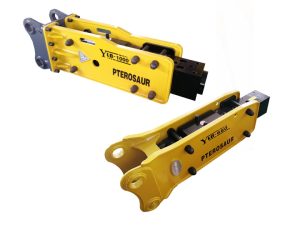
In the world of construction and excavation, rock breakers play a pivotal role in efficient and effective rock and concrete demolition. A rock breaker machine, often referred to as a hydraulic hammer, utilizes hydraulic power to deliver repeated impacts, effectively breaking apart hard materials such as rock and concrete. These machines have become indispensable in various industries, including mining, construction, and landscaping.
The Evolution of Rock Breakers
The history of hydraulic breakers dates back to 1967 with the introduction of the Krupp HM 400, marking the beginning of mass-produced rock breakers. Since then, these powerful tools have evolved significantly, enhancing their effectiveness and efficiency. Today, companies like Epiroc offer a wide range of hydraulic breakers designed to cater to different project needs, from small excavators to heavy-duty machinery.
Key Features of Hydraulic Rock Breakers
Hydraulic rock breakers are characterized by their robust construction and versatile applications. Some notable features include:
- Variety of Sizes: Hydraulic breakers are available in multiple sizes, making them suitable for various types of excavators, backhoes, and skid steers. This adaptability allows for precision work in tight spaces or heavy-duty tasks in large areas.
- High Breaking Force: Modern rock breakers are engineered to deliver significant breaking force, making short work of dense materials. This is crucial in projects where efficiency and speed are paramount.
- Safety and Control: Unlike traditional explosive methods, hydraulic breakers offer a controlled approach to rock demolition. This not only enhances safety on-site but also minimizes the unpredictability often associated with blasting.
Applications of Rock Breakers
The versatility of rock breakers is evident in their broad range of applications:
- Construction: Used for demolition tasks, breaking up concrete structures, and clearing sites for new builds.
- Mining: Essential for breaking oversize rock before it is moved, ensuring efficient material handling.
- Trenching: Facilitates the creation of trenches for utilities, foundations, and drainage systems.
Choosing the Right Rock Breaker
When selecting a rock breaker, it’s essential to consider compatibility with the excavator. Factors to evaluate include:
- Weight: The weight of the rock breaker should match the capabilities of the excavator to avoid damaging the machinery or compromising performance.
- Hydraulic Flow Requirements: Ensure that the hydraulic flow of the excavator aligns with the rock breaker’s specifications for optimal functionality.
- Mounting System: Check the mounting system to ensure a secure fit, facilitating effective operation.
Conclusion
Hydraulic rock breakers are indispensable tools that have transformed the landscape of construction and excavation. With a history of innovation and continuous improvements in design and functionality, they are designed to tackle the most challenging rock and concrete demolition tasks with efficiency and precision. Whether for large-scale mining operations or smaller construction projects, understanding the features and applications of rock breakers can lead to more successful and productive work environments.
For further information about hydraulic breakers for excavators, including product specifics and customer support, consider contacting Epiroc or your nearest equipment provider.
